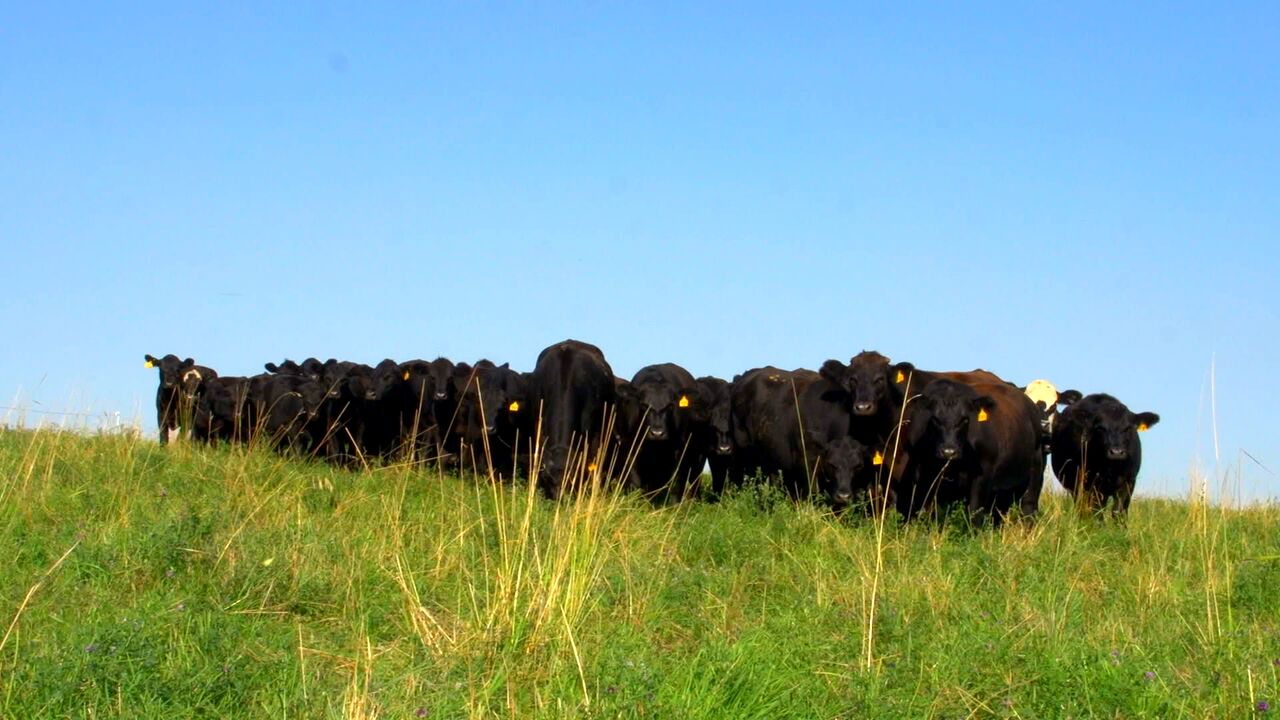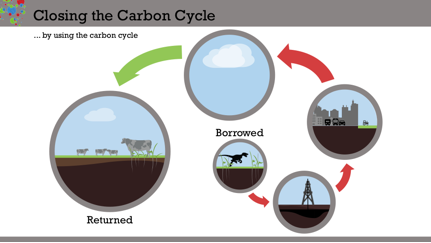土壤碳牛仔的兴起

牧场是一种罕见的职业。更为罕见的是,牧场主们开拓新的放牧方式,将牧场和农场改造成充满活力的生态系统,为他们的银行账户生产黑色墨水,让他们难以置信的健壮的动物过上美好的生活(除了一个糟糕的日子)。
These new grazing methods have many names — mob grazing, managed intensive grazing, holistic management. Our group of scientists and ranchers call it Adaptive Multi-Paddock (AMP) Grazing.
As you can see in our short film, "Soil Carbon Cowboys" (it’ll take you 12 minutes), AMP grazing helps ranchers regenerate their soils, with cascading benefits: More water soaks into and stays in the soil; soil microbes thrive; plant nutrition and production levels take off; and wildlife — from bugs to birds to large mammals — flocks to the ranches.
It’s a powerful story of how nature works — get the soils healthy, and the whole system rocks.
I’m fascinated with AMP grazing because of its potential to help slow climate change.
Those bustling plants and microbes need carbon to live; their storehouse of choice for carbon is atmospheric carbon dioxide (CO2). Via photosynthesis, plants suck CO2 out of the air, give us oxygen (O2) to breath and send carbon down through their roots to the microbes.
Simply put, there are three lengths of time carbon stays stored in the soil: days, decades and centuries.
When the microbes exhale carbon, it’s back in the atmosphere in a matter of days. When carbon gets locked up in dead roots, it stays in the ground for decades. When carbon binds with the actual building blocks of the soil, it’s stored in the ground for centuries, if not longer.
这个古老的碳a great effect on climate change — if enough ranchers start practicing AMP grazing.
Carbon farming meets fossil fuels?
就在我开始研究“土壤碳牛仔”的同时,我被介绍给了壳牌游戏改变者-壳牌石油公司的风险投资基金,寻求一些不同寻常的想法。
我的想法是:我们知道壳牌和其他石油公司正在花费数十亿美元在碳捕获和储存上,或者用机械手段在排放源捕获二氧化碳。然后,二氧化碳被压缩并泵入地下一英里(约)的空油或天然气沉积物中。
But what if these oil companies used their money to help ranchers transition to AMP grazing, and then shared in the credits for the carbon being stored in the soil? What if those soil carbon storage credits were cost effective for the oil companies to buy, while that same soil carbon increase helped the ranchers reduce operating costs due to a more robust ecosystem on their land, where nature takes the place of fertilizers, herbicides and pesticides?
如果我们能关闭化石燃料碳的循环呢?我们利用能量,然后把碳返回土壤。

We got two grants from GameChanger. The first looks at potential business models for Shell (and other companies) that focus on soil health as a way to increase profits and reduce carbon intensity. We plan to release this research in the coming months.
The second grant is to actually measure the soil carbon on both AMP and conventionally grazed ranches to see if there’s a quantifiable difference in that long-term, centuries carbon being stored in the soils. This research is in progress, and we plan to publish in 2016.
第二笔拨款是基于德州农工大学的理查德·蒂格先前的研究成果。蒂格研究了德克萨斯州北部的一组AMP和传统牧场。他10年的学习showed that the AMP grazers’ lands were accruing three tons of carbon per hectare per year more than their conventional neighbors.
There are 3.5 billion hectares of grazing land on earth. If — and this is a big if — we could store just one ton of additional carbon per hectare annually over all 3.5 billion hectares, then we would be able to draw down just about the same amount of carbon we emit each year that doesn’t get absorbed by the oceans, trees, plants and soils — nearly cancelling out the leftover carbon that’s causing climate change.
But, as my scientist friends say, it is much more complicated than that.
What scientists can learn from ranchers
在拍摄《土壤碳牛仔》的过程中,我遇到了一群科学家,他们非常兴奋地想了解更多关于AMP放牧的知识,以及它是否改善了他们对重点领域的具体研究,例如土壤微生物和真菌、温室气体通量、放牧系统、养牛、昆虫、农业经济和草成品牛肉生产。
从那时起,我们成立了一个完整的系统科学研究团队,研究这些AMP牧场主是否、如何以及为什么在他们的土壤中储存额外的碳,以及这些碳是如何影响水循环、生物多样性(微生物、昆虫、植物和野生动植物)、动物和牧场主的福祉以及温室气体排放。
Bring on the complication; these ranches also emit greenhouse gases such as CO2, nitrous oxide and methane.
最大的问题是平衡。储存的土壤碳的温室气体当量(GHGe)是否高于排放的二氧化碳、一氧化二氮和甲烷的温室气体当量?基本上,AMP牧场是净碳汇还是碳排放国?我们团队的早期数据表明下沉。
The cattle’s diet is also part of this GHGe equation. Many AMP grazers produce grass-finished beef, where animals are finished on grass and never sent to a feedlot. Most cattle in the U.S. are sent to feedlots and fed corn to promote rapid weight gain.
我们的团队将研究草制品和玉米饲料牛肉的GHGe,包括两个关键项目:
1. Because grass-finished cattle live about a year longer than corn-finished, which animals produce more methane in their lifetimes?
2如果包括与玉米生产相关的土壤侵蚀,种植玉米的碳足迹是多少?美国农业部说,在爱荷华州每种植1磅玉米,就有2磅土壤因侵蚀而流失。因为土壤含有碳,这可能是一个巨大的碳流失。
People trust nature
This is just a slice of the whole systems science we are proposing. Whole systems science is messy, complex and expensive.
在我们的第一个商业模式游戏改变者奖助金中,我们与来自商业、农业、政府、非政府组织、学术界和科学界的100多名思想领袖进行了交谈。
We came away with three key insights about soil carbon storage via AMP grazing: People trust nature; finally, we can see a scalable environmental solution for climate change; and this solution creates common ground for political opponents.
2014年6月,犹他州众议员、茶党共和党人、众议院自然资源委员会主席罗布·毕肖普(Rob Bishop)成为第一位就土壤碳问题举行听证会的国会议员。
He is a strong proponent of the potential of AMP grazing being a viable solution to climate change. Will he do a good job inspiring more legislators to focus on soil carbon storage?
在9月份的“人民气候游行”中,有40万人走上了纽约街头,我猜其中大约98%的人相信牛肉生产本身就是导致气候变化的重要因素。
当考虑到密集的玉米生产和砍伐牧场时,他们提出了有力的理由。因此,对他们来说,AMP放牧实际上可能是一个伟大的气候解决方案,可以产生健康的食物、干净的水和充满活力的生态系统,这一点特别违背直觉。
很少有人想当牧场主——在这少数人中,有一小部分人是放牧的先驱,在重新种植土地的同时赚了很多钱。
会有更多的牧场主追随他们的脚步吗?更好的是,这是临界质量在它发生前几年的样子吗?

